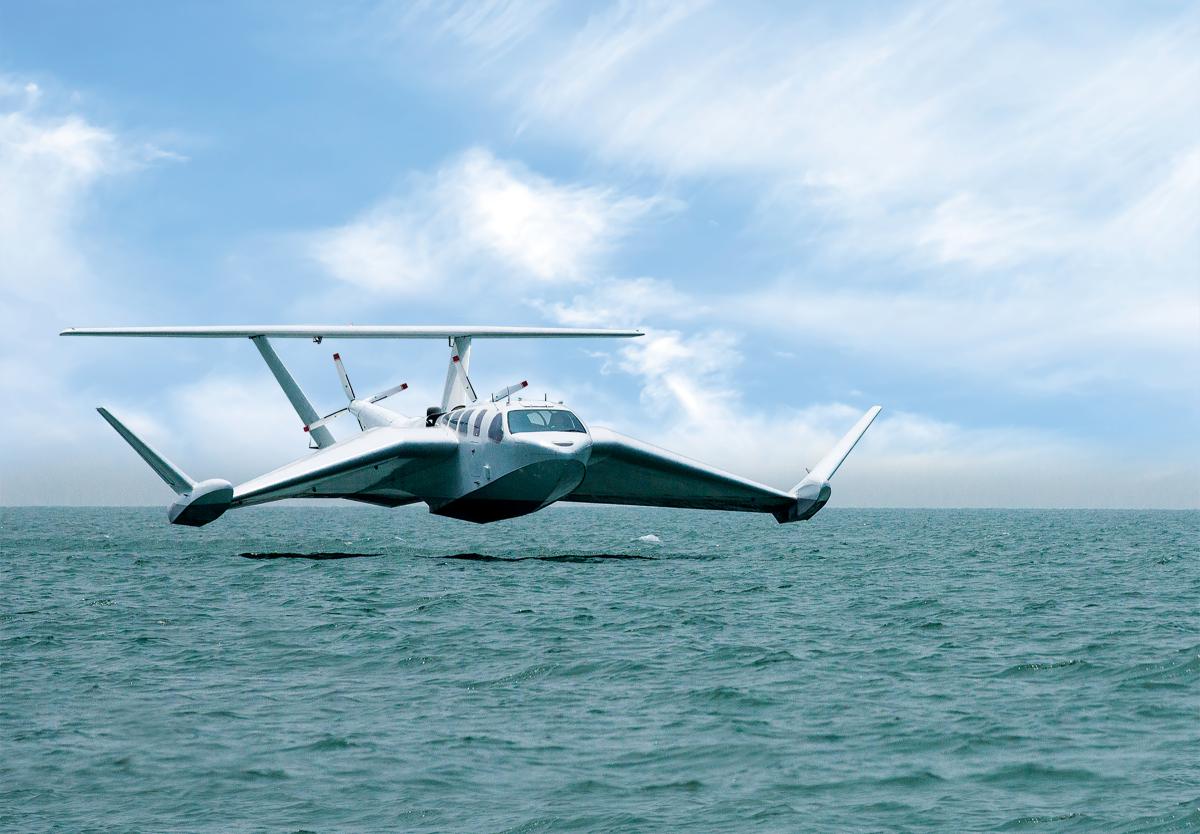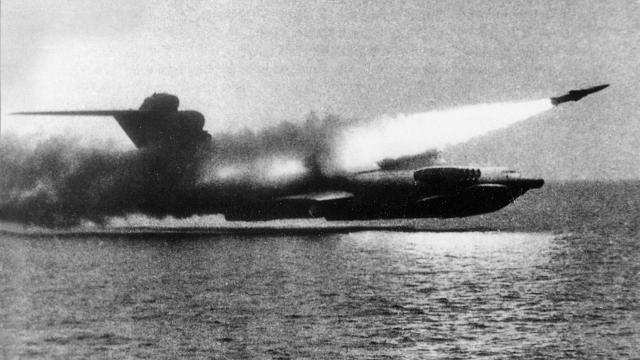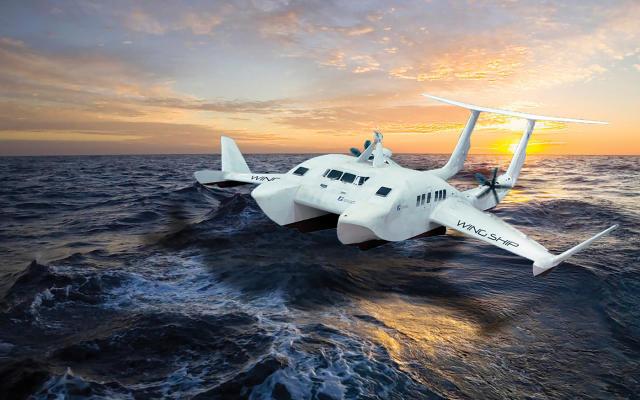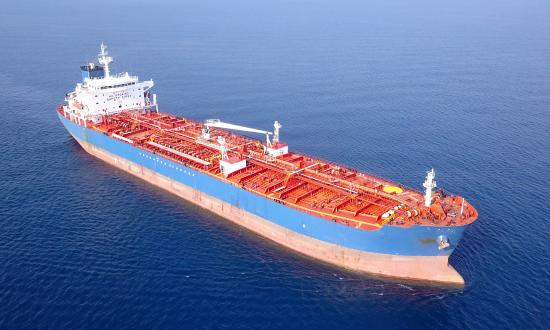When CIA analysts first saw it in satellite photographs, they didn’t know what it was. It was the size of a boat and operated from the water, but it seemed to have wings. Was it a plane? If so, it was larger than any plane they knew of. Was it nuclear powered? They did not know—and would not for several more years. Though there were more questions than answers surrounding this mysterious craft, they gave it a name: the Caspian Sea Monster.1 In fact, it was a massive waterborne wing-in-ground-effect (WIG) vehicle.2
From the 1960s to the early 1990s, the Soviet Central Hydrofoil Design Bureau (CHDB) built several WIG prototypes and operated them on the Caspian Sea.3 Intended for a wide range of duties, the unusual craft could move at aircraft speeds and carry ship-like tonnage, all while operating completely from the water. The United States has investigated building its own WIG craft, but not since the early 2000s.
With current threats challenging the United States’ ability to operate fixed-wing aircraft from both carriers and land bases and the country’s strategic sealift capacity in its worst condition in decades, the Department of Defense should reexamine WIG aircraft for development and acquisition. Unlike new, emerging technologies, which offer great potential but, in most cases, have yet to get very far off the drawing board, WIG craft are proven and have inherent capabilities that make them ideal for the Navy and Marine Corps’ vision of how they would fight a Pacific war.
Vulnerable Airfields, Not Enough Ships
China and Russia are increasingly able to target large U.S. ships and fixed bases with long-range missiles. A 2017 RAND Corporation report argued that Chinese missiles could shut down U.S. airbases for more than 40 days at the outset of a conflict, even if the bases were being continuously repaired. As one analyst put it: “Kadena [Air Force Base, Japan] is like a sitting duck susceptible to missile attacks.”4
But by far the biggest worry is strategic sealift. With justifiable alarm, the lead author of a 2019 Center for Strategic and Budgetary Assessments report remarked:
Although logistics has traditionally been a U.S. strength, it now risks becoming a major weakness that could cause the United States to lose a war against China or Russia.5
The small number of Military Sealift Command (MSC) ships will face an increasingly contested environment, as People’s Liberation Army Navy (PLAN) submarines operate farther from home waters. Each ship will be largely “on its own” because of a lack of available escorts.6 If the current, meager sealift fleet were to take losses, the United States would be hard-pressed to replace them, as the U.S. commercial shipbuilding industry is in crisis, and merchant mariners are increasingly hard to find.7
It is clear the United States needs a new way to move troops and supplies across the seas. New classes of Navy and Marine Corps WIG craft could dramatically increase the intratheater mobility of expeditionary forces in the Pacific and improve resupply from the United States and allies. Not only do WIG craft not require use of a runway, but they also can carry more cargo than conventional aircraft and travel nearly as fast while using less fuel. Developing and fielding amphibious WIG craft (capable of operating from the water or from paved runways) would effectively turn vast swaths of the western Pacific into potential airports and logistics hubs, significantly increasing Navy/Marine Corps freedom of maneuver while considerably complicating the PLA and PLAN’s targeting.8
What is Wing-in-Ground Effect?
Wing-in-ground effect occurs when a craft is flying no higher than the length of its wingspan above the ground or water.9 Within that distance, induced drag decreases, which increases the lift the wing can generate at a given speed. This effect is familiar to any pilot or passenger who has experienced a long “float” down a runway during a landing attempt. The wing also creates a kind of “cushion” of air at relatively high pressure caught under the craft.10 The decreased drag improves fuel consumption as well. The result is a dramatic increase in the aerodynamic lift generated by the craft, for the size of the wings and the fuel burned, allowing it to carry great masses of cargo.
In short, WIG allows for the design of craft that can cruise above any relatively flat surface—oceans, rivers, lakes, deserts, and even pack ice—with a cargo capacity approaching that of a logistics vessel, but at the speed of an aircraft.
In military and civilian markets, WIG craft are generating new interest. Russia’s military is again investing in WIG vehicles for maritime and Arctic use, seeing them as “a relatively low-risk and cost-effective investment” and an “access weapon.” It recently announced they would be part of the State Armament Program for 2018–27.11 The Alexeev Hydrofoil Design Bureau, descendant of the Soviet-era CHDB, continues to design WIG aircraft in several sizes for a variety of commercial uses. The Chinese military is reportedly interested in acquiring WIG aircraft from Russia for use in the South China Sea.12 The Iranian Navy also fields a fleet of much smaller, domestically designed WIG aircraft for missions in the Persian Gulf.13
Given the significant interest in WIG from potential U.S. adversaries, it is puzzling that the Department of Defense and the U.S. aerospace defense industry have not seriously considered WIG craft in almost two decades. This is particularly curious given the Navy’s long experience with amphibious aircraft, fielding more than 1,500 PBY Catalinas during World War II, developing the world’s first jet-powered seaplane—the Martin P6M SeaMaster—and operating the Martin P5M Marlin until 1967. Possibly this is because WIG vehicles are bureaucratic orphans: too “aircraft” for the Navy, too “ship” for the Air Force. As a result, perhaps it is not surprising that the Army came closest to developing WIG craft.14
The Pelican
In the late 1990s, the U.S. military became interested in developing a capability to provide “prompt response”—the ability to rapidly deploy entire combat units around the world in only 120 hours. In its 1999 Transformation Roadmap, the Army noted:
There are also unique emerging technologies that will enhance assured access capabilities. Initiatives such as . . . [the] large ground effect aircraft and Ultra-Large Airlift (ULA) provide immense capability to improve strategic responsiveness.”15
A 1999 National Research Council report, Reducing the Logistics Burden for the Army after Next: Doing More with Less, made note of the same technology as a potential means of improving tactical, operational, and strategic mobility:
[A Soviet] WIG design, known as the Lun, weighed 380 tons and was considered to be a threat by Russia’s Scandinavian neighbors because a fleet of 10 could have crossed the Baltic Sea with minimal radar signature in 12 minutes and deposited 5,000 troops without warning.16
Boeing responded to this interest by beginning design work for a massive new aircraft, dubbed the Pelican Ultra-large Transport Aircraft (ULTRA), which would conceivably carry up to ten times as much cargo as any extant aircraft—up to 2.8 million pounds—and carry it ten times faster than any ship, at around 300 miles per hour.17 The engineers worked with Defense Advanced Research Projects Agency researchers who had gained access to the Russian work on WIG aircraft in 1993, just after the fall of the Soviet Union. The Pelican would be a scaled-up version, but the Soviets had already demonstrated that WIG craft—“ekranoplan” in Russian—worked, and they could be massive. Ultimately, the Boeing project was canceled because of shifting Army budget priorities in the early 2000s and Operation Iraqi Freedom.
Revisiting WIG Aircraft
The Department of Defense should reexamine WIG craft for two roles: tactical intra- and strategic intertheater lift.
The Navy and Marine Corps should pursue an amphibious design similar to proven Soviet and Russian WIG designs as an alternative for or supplement to surface connectors and smaller transport vessels, such as the expeditionary fast transport (EPF), for intratheater lift and assault missions. Smaller designs can move passenger and cargo loads similar to those of an EPF, up to about 1,500 tons, but ten times as fast and with a much smaller crew.
U.S. Transportation Command should foster ultra-large amphibious designs for strategic inter-theater lift.18 A Pelican-sized aircraft could easily outlift an EPF at a similarly huge speed advantage, carrying perhaps 5,000 tons. In fact, a very large, mature amphibious WIG craft would compare favorably against ships currently being developed to fill the gap in overall sealift.
However, heavy lift at speed is not the WIG craft’s only advantage.
While not invulnerable, WIG craft offset many of China’s antiaccess/area-denial (A2AD) investments. Flying at approximately 200 feet, they would be almost invisible to Chinese radars, hidden by the curvature of the Earth and flying much too fast for real-time satellite detection. At low altitude above the water, they would be largely immune to threats from long-range surface-to-air-missiles, antiship ballistic missiles, submarines, and mines. As such, they would be significantly more survivable than amphibious ships, EPFs, or strategic sealift ships.
WIG craft also allow for a more distributed, flexible, and resilient supply chain. Within a theater, instead of supplies being concentrated in a few slow ships, supplies could be distributed among numerous smaller and faster connectors, limiting the impact of any one loss and allowing for networked versus hub-and-spoke logistics.
WIG craft also hold the key to realizing distributed concepts such as littoral operations in a contested environment (LOCE) and expeditionary advanced base operations (EABO). Executing these concepts will require advances in logistics to employ and sustain “inside forces.” The speed, lift, and amphibious capability of WIG vehicles is one of the few readily available solutions to the future logistics problems these emerging concepts pose. Manned or unmanned WIG craft could employ, sustain, and withdraw Marine expeditionary forces at a lower risk than any available alternative.
WIG craft have applications beyond the Pacific. They also could be ideal for use as fast transports and connectors in the Mediterranean, Caribbean, Caspian, and Baltic Seas, where they could connect U.S. forces with bases and allies in hours instead of days. They also would be effective in the Arctic and the extensive river systems of the Far North, where large expanses of flat ice and snow would be ideal for WIG aircraft operations. Russia has been leading the United States in resources and new investments in the Caspian and Black Seas, as well as the Arctic, for some time, and now its military is investing in its proven WIG designs to operate there.
A final advantage is that, unlike many promising new technologies—artificial intelligence, directed-energy weapons, and hypersonics—WIG technology has existed for more than 50 years. Both Boeing and Lockheed Martin already have concepts, if not plans, for these craft. The United States may not build many cargo ships anymore, but it still builds aircraft and trains aircrews. With rapid prototyping and appropriate acquisition authorities and budget, it may be possible to have the first vehicles flying within five years.
None of this is to say developing WIG craft will be without challenges. A frequent criticism is that an aircraft flying close to the surface of the water is at risk of being affected by adverse weather. However, any ship or aircraft must account for the effects of weather on its operations and plan its voyage accordingly. In fact, the actual wave height that would preclude WIG operations is higher than the wave height that would halt operations of the Navy’s most comparable surface connector, the EPF. A testing report on the EPF’s capabilities says that in seas above sea state 5 (waves approximately 8 to 13 feet) “the ship can only hold position and await calmer seas.” Whereas large WIG aircraft could continue to operate in sea state 6 (approximately 13 to 20 feet), according to publications from the Alexeev Hydrofoil Design Bureau.
Critics could also point to the turbulence and airframe stress inherent in low-altitude air operations, the need to avoid shipping, and the persistent challenge of corrosion from sea spray. While valid, these limitations could be significantly reduced through the application of modern sensing, fly-by-wire, composite materials, and coating technologies.
Professionals Talk Logistics
A mixed fleet of WIG craft would turn the Pacific theater’s tyranny of distance into a decisive advantage in favor of U.S. forces. With “connector” WIGs, Marines based in the Second Island Chain would be free to wreak operational havoc on contested objectives inside the First Island Chain, without needing to rely on airfields or L-class ships, and could respond to provocations in hours, not days.
While ultra-large WIG craft likely would not completely replace seaborne logistics and transport in the Pacific, they could certainly supplement them and provide a unique capability for assault and fast transport that currently is only possible with legacy C-5A Galaxy and C-17 Globemaster aircraft, which are useless without access to runways and basing infrastructure. WIG would be useful to deploy and support U.S. forces in the Arctic and in littorals around the globe. But, most important, they would be ideal for penetrating and operating inside an A2/AD network in support of an “inside force.” What’s old is new again, and the Navy and Marine Corps should pursue “modern sea monsters” to win the future fight.
1. Bill Sweetman, “Monster at 20 Ft.,” Popular Science, 22 January 2003.
2. Raymond L. Garthoff, “The Swallow and Caspian Sea Monster vs. The Princess and the Camel: The Cold War Contest for Nuclear Powered Aircraft,” Studies in Intelligence 60, no. 2 (June 2016), 9.
3. Peter Garrison, “Water Skimmers,” Flying 121, no. 7 (July 1994): 71.
4. Seth Robson and Leon Cook, “Chinese Missile-Test Sites Appear to Mirror US bases in Japan,” Stars and Stripes, 21 March 2017.
6. Center for Strategic and Budgetary Assessments, “Sustaining the Fight: Resilient Maritime Logistics for a New Era,” 23 April 2019.
6. David Larter, “‘You’re on Your Own’: US Sealift Can’t Count On Navy Escorts in the Next Big War,” Defense News, 10 October 2018.
7. CAPT Douglas R. Burnett, USN (Ret.), and RADM Christopher McMahon, USMS, “Losing the Great Pacific War for Lack of Ships and Mariners,” U.S. Naval Institute Proceedings 145, no. 1 (January 2019).
8. Amphibious craft could operate from paved airfields or water when necessary.
9. The term “craft” is used because, while WIG vehicles’ design, construction, and operation have a high degree of commonality with aircraft, they operate with other waterborne craft and must necessarily follow the same International Maritime Organization collision avoidance rules as conventional shipping.
10. Michael Halloran and Sean O’Meara, Wing in Ground Effect Craft Review (Melbourne, Australia: Royal Melbourne Institute of Technology, 1999), 2–6.
11. Joseph Trevithic, “Now Russia Wants to Bring Back Missile-Armed Ekranoplans to defend Its Claims in the Arctic,” The Drive, 30 July 2018.
12. Brian Wang, “China Seeks 100-Passenger Wing In Ground Effect Ekranoplan and Larger Seaplanes for South China Sea,” Next Big Future, 19 October 2015.
13. Sebastien Roblin, “Small and Deadly: Iran’s Speedboats Should Not Be Underestimated,” The National Interest, 25 January 2020.
14. In fact, the United States has previously developed an ultra-large WIG vehicle. Contracted in 1942, the Hughes H-4—the Spruce Goose—made its only flight on 2 November 1947 in ground effect.
15. U.S. Army, Army Transformation Roadmap (Washington, DC: Department of Defense, 1999), appendix B-4.
16. National Research Council, Reducing the Logistics Burden for the Army After Next: Doing More with Less (Washington, DC: The National Academies, 1999), 68.
17. Michael A. Dornheim, “Boeing Sketches 500-ft Transport,” AviationNow.com, 14 October 2002.
18. In the mid-2000s, Lockheed Martin’s proposed Surface-Effect Aircraft was designed to carry the same payload as a C-5, about 270,000 pounds, with a range of 7,500 to 10,000 nautical miles depending on whether it was operating in or out of surface effect. It had an operational goal of 300–400 knots at less than 200 feet, but could also fly at normal deployment altitudes.











